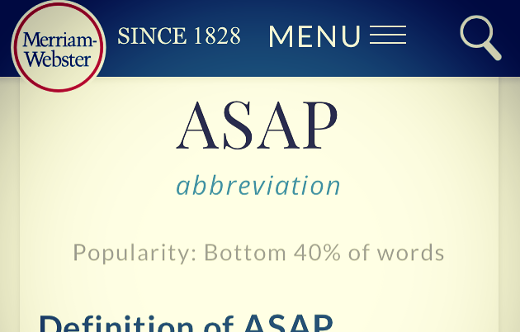Thriving In A Culture of ASAP
When you see “ASAP” in an email or text, do you cringe? Sadly most of us do – I do – as the acronym, which is made up of pleasant words, has ended up becoming a harsh term.
Looking up the definition of ASAP in the dictionary you see it stands for “as soon as possible” which is, as I said, pleasant. But thinking back to the cringe-causing event (or more likely events) that come to mind when you read the opening of this post, do you think the person typing ASAP really meant “as soon as possible?”
Hell no I can hear you say! Rather than asking you to do something as soon as it is possible for you to do so, aren’t they really asking, “drop all you are doing and respond to this right this fucking second!” Let’s be honest, this is what should be listed in the dictionary as the true definition of what ASAP means, and not just the words behind the acronym.
The Culture of ASAP
Most organizations have a culture of ASAP. In this hyper-connected world where any information can be had in seconds, we have a heightened expectation that seems to come with a narrowing window as time goes on.
Note I say “any” information and not the “right” information or even accurate information, or any other qualifying adjectives that requires strategic thinking. This has no place in the culture of ASAP, as everything is being responded to fast and furiously. Even if the answers or responses have already been prepared and presentation in reports or dashboards, the person slinging ASAP around has no time for these tools and want the answers from you and right now, though ironically they may be the owner of said reports and dashboards.
Succeeding Under ASAP
It goes without saying that to get beyond a culture of ASAP takes leadership. Part of that leadership is in communications – sharing expectations of greater foals and what may be asked of a team. As well, the team is given time to ideate and strategize the big picture down to their area of expertise and can thus be proactive in using information sources or channels.
In the absence of that leadership, there is still the ability to make gains and efficiencies yourself to make your life easier. Simply documenting ASAP requests is a great start, by recording overall what is being asked, looking for trends, and comparing it to what you are doing now. Incremental improvements to processes or reporting can be made as a result of this analysis. As requests come in, make sure you are clear as to what is being asked and – if appropriate – why it is being needed. The “why” can influence “what” is created. These latter steps are things I do on a routine basis to make both the collection of data and reporting of information much more efficient.
Deconstructing ASAP
Priorities in business change frequently and requests can come in that need to take top priority. With some analysis and a small series of successful changes, dealing with ASAP can be made much less harsh, as it is likely to not go away altogether.
This is from The Hot Iron, a journal on business and technology by Mike Maddaloni.
Did you enjoy this? Subscribe to The Hot Iron by RSS/XML feed or Read by Email.
Business • Strategize • Thrive • (2) Comments • Permalink




